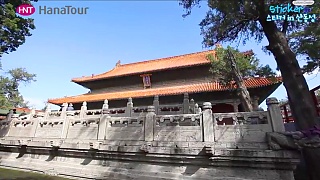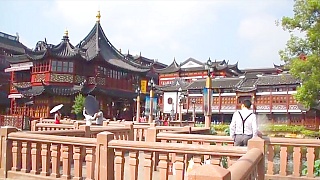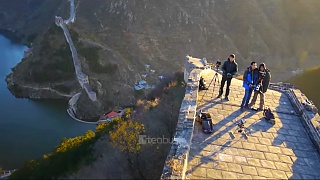With Blondie in China ...
[640],shadow=true,start=,stop=With Walk East ...
Qingdao, located in the eastern part of China's Shandong Province, is a beautiful coastal city known for its European-style architecture, stunning beaches, delicious seafood, and vibrant cultural scene. Here's a guide for tourists visiting Qingdao:
Beaches: Qingdao is famous for its golden sandy beaches. The most popular ones include the No. 1 Bathing Beach, which is located near the city center and offers various water activities such as swimming and jet skiing. Golden Beach and Silver Beach are also worth visiting for their picturesque scenery and clean waters.
Tsingtao Beer Museum: As the birthplace of Tsingtao Beer, Qingdao is home to the Tsingtao Beer Museum. Visitors can learn about the history of beer brewing in Qingdao, see vintage brewing equipment, and enjoy beer tastings.
Pier and Zhanqiao: Zhanqiao Pier is one of Qingdao's most iconic landmarks. Visitors can walk along the pier, which extends into the sea and offers panoramic views of the coastline and nearby islands. The nearby Huilan Pavilion is a great spot for taking photos.
Laoshan Mountain: Located just outside the city, Laoshan Mountain is a scenic area known for its Taoist temples, lush forests, and hiking trails. Visitors can take a cable car to the mountaintop for breathtaking views of the surrounding landscape.
Qingdao Underwater World: This aquarium is home to thousands of marine creatures, including sharks, dolphins, and colorful tropical fish. It's a great place to visit, especially for families with children.
German Architecture: Qingdao has a unique blend of Chinese and European architecture, reflecting its colonial past. The Badaguan Scenic Area is famous for its tree-lined streets and well-preserved villas built during the German colonial period.
Local Cuisine: Qingdao is known for its delicious seafood, particularly its fresh oysters, clams, and prawns. Be sure to try local specialties such as seafood hotpot, grilled squid, and seafood pancakes.
May Fourth Square: This expansive public square is named after the May Fourth Movement and features the iconic May Wind sculpture. It's a popular spot for leisurely strolls and people-watching.
Island Hopping: Qingdao is surrounded by several small islands, including Zhangqiu Island, Huangdao Island, and Dayang Island. Visitors can take boat tours to explore these islands, relax on their beaches, and enjoy water sports.
Qingdao International Beer Festival: If you happen to visit Qingdao in late summer, don't miss the annual International Beer Festival held in August. It's one of the largest beer festivals in Asia, featuring live music, cultural performances, and of course, plenty of beer.
Whether you're interested in history, culture, outdoor activities, or simply relaxing by the sea, Qingdao offers something for every type of tourist to enjoy.
Chinese cuisine is an intricate tapestry of flavors, techniques, and regional specialties that has evolved over thousands of years. From the fiery spices of Sichuan to the delicate dim sum of Cantonese cuisine, every region of China offers its own culinary delights. For visitors to China, exploring the diverse and dynamic world of Chinese food is an essential part of experiencing the country's rich cultural heritage. Here's a more extensive exploration of Chinese cuisine for visitors:
Regional Diversity:
Sichuan Cuisine: Hailing from the southwestern province of Sichuan, this cuisine is famed for its bold, spicy, and numbing flavors. Sichuan peppercorns, chili peppers, and aromatic spices are used liberally in dishes like Mapo Tofu, Dan Dan Noodles, and Sichuan Hot Pot, creating a symphony of flavors that tingles the taste buds.
Cantonese Cuisine: With its emphasis on fresh ingredients and delicate flavors, Cantonese cuisine is highly regarded for its seafood dishes, roasted meats, and dim sum. Steamed fish, Char Siu (barbecue pork), and Har Gow (shrimp dumplings) are just a few examples of the exquisite dishes that showcase Cantonese culinary mastery.
Shanghai Cuisine: Reflecting its coastal location and cosmopolitan history, Shanghai cuisine combines influences from Jiangsu, Zhejiang, and Anhui provinces. Sweet and Sour Mandarin Fish, Shanghai Soup Dumplings (Xiaolongbao), and Drunken Chicken are some of the signature dishes that highlight the diverse flavors and textures of this culinary tradition.
Beijing Cuisine: As the capital of China, Beijing boasts a rich culinary heritage deeply rooted in imperial traditions. Peking Duck, a dish with crispy skin and succulent meat served with pancakes and hoisin sauce, is a quintessential Beijing delicacy. Other notable dishes include Zhajiangmian (Beijing Noodles), Mongolian Hot Pot, and Beijing-style meat pies.
Hunan Cuisine: Known for its bold and aromatic flavors, Hunan cuisine features dishes that are spicy, sour, and intensely flavorful. Chairman Mao's Red-Braised Pork, Dong'an Chicken, and Steamed Fish Head with Chopped Chili exemplify the fiery and robust nature of Hunanese cooking, which makes ample use of chili peppers, garlic, and fermented ingredients.
Street Food and Snacks:
Jianbing: This savory Chinese crepe is a popular breakfast option, consisting of a thin pancake filled with eggs, scallions, cilantro, and various fillings such as crispy fried dough, pickled vegetables, or chili sauce.
Baozi: These steamed buns are filled with a variety of savory or sweet fillings, including pork, vegetables, or red bean paste. Baozi are a popular street food snack and can be found in teahouses, markets, and street stalls across China.
Roujiamo: Often referred to as Chinese Hamburgers, roujiamo features savory braised meat stuffed inside a flatbread, offering a hearty and flavorful snack that's perfect for on-the-go eating.
Dining Etiquette and Customs:
Family-Style Dining: Chinese meals are typically served family-style, with multiple dishes shared among diners seated around a table. It's customary to use chopsticks to pick up food from communal dishes and to serve elders before oneself.
Toasting and Ganbei: When dining with Chinese hosts, expect toasts (ganbei) with alcohol, usually baijiu (Chinese liquor). It's polite to reciprocate the toast and drink in moderation, but declining politely is acceptable if you don't drink alcohol.
Tea Culture: Tea is an integral part of Chinese dining culture, with a wide variety of teas available to complement different dishes. Green tea, oolong tea, and pu'er tea are among the most popular choices, and serving tea to guests is a sign of hospitality and respect.
Street Markets and Night Markets:
Wangfujing Snack Street, Beijing: Located near the Forbidden City, this bustling street market offers a wide variety of traditional snacks, street food, and local delicacies. Visitors can sample everything from scorpions on a stick to traditional Beijing snacks like Jianbing and Tanghulu (candied fruit skewers).
Shanghai Old Street, Shanghai: Nestled in the heart of the city's historic district, Shanghai Old Street is a bustling marketplace where visitors can explore narrow alleyways lined with traditional shops, street vendors, and food stalls. From steamed dumplings and stinky tofu to hand-pulled noodles and sugar-coated haws, there's something to satisfy every craving.
Dietary Considerations:
Vegetarian and Vegan Options: While Chinese cuisine traditionally features a wide range of meats and animal products, vegetarian and vegan options are becoming increasingly available, especially in larger cities and tourist destinations. Buddhist restaurants (????, sùshí c?nt?ng) often offer meat-free versions of classic dishes, and plant-based ingredients like tofu, mushrooms, and seasonal vegetables are widely used in Chinese cooking.
Exploring the diverse and delicious world of Chinese cuisine is an essential part of any visit to China. From regional specialties and street food snacks to dining etiquette and cultural customs, the culinary landscape of China offers a rich tapestry of flavors, traditions, and experiences that are sure to delight and inspire visitors from around the world. Bon appétit!.

 A look around QingDao, ShanDong province
A look around QingDao, ShanDong province



























